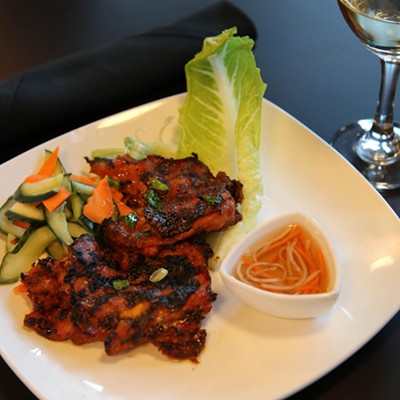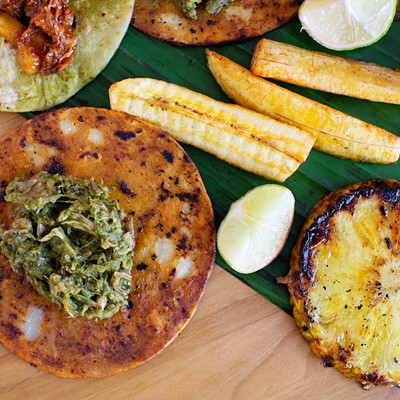Salt can make or break nearly any dish: Too much, and the dish is rendered inedible; too little, and the dish is bland.
It brings together everything from salads to desserts. Complex flavors develop; savory hints of subtle flavors appear with the right amount. Wars have been fought over it. It might be the single most important element in food.
Young or inexperienced chefs are often unsure of salt—how much to use, what should be salted. Of course, how much salt is a personal preference, one that must be taken into careful consideration by the chef.
But out of respect for the food, don't just skip the salt.
My first dinner visit to Amici Ristorante Italiano required lots of added salt. The appetizers, a mussel special ($11.99) and a fried calamari special ($10.99), which are apparently almost always on special (Why not just put them on the menu?) lacked the punch that a little well-timed salt would have added. Adding table salt after cooking only adds a salty flavor to the outside, instead of developing and accentuating the flavor of the food. Most restaurant kitchens use kosher salt during the cooking process, because the salt flakes are larger and less uniform, allowing them to dissolve. The mussels, described by our server as cooked in a spicy white-wine sauce, were not at all spicy and were extremely overcooked, making them tough and chewy. The six slices of garlic bread they were served with were so overwhelmed by butter and oil that they were completely inedible, the only detectable flavor being grease. The calamari was slightly better, with a nice, crunchy texture, but was bland until doused in lemon.
Our server was robotic and over-recited, coming to the table and interrupting with questions an annoying amount of times. After the appetizers and two spoonfuls of the disappointing mushroom spinach marinara soup—which tasted like nothing more than stereotypical marinara sauce (also lacking salt)—I was not looking forward to entreés. The kitschy Italian decor and loud Italian music were not helping matters.
After 10 or so visits to the table, our server dropped off our entrées, a gnocchi Sorrento ($14.99) and a scalloppina picata (sic) ($19.99). The gnocchi was a beautifully presented plate, with a large portion with shaved Parmesan and a big, fresh basil leaf adorning the pile of steaming pesto-coated gnocchi. The scalloppina was two tiny, thin veal cutlets, maybe as large as my palm, served with piccata sauce (traditionally lemon, capers and white wine), fried potatoes and veggies. It smelled lovely—piccata is one of my favorite Italian dishes—but I thought the portion size was quite small for the price.
Again, both dishes suffered from a lack of precision in execution. The gnocchi tasted as though the water it was cooked in was not salted (a big no-no when it comes to pasta); it was slightly overcooked and therefore chewy, and the pesto was bland. The piccata had the opposite problem: There were too many capers, which didn't appear to be rinsed of their super-salty brine, making the dish almost unbearably salty. The thin, delicate veal had the tenderness cooked out of it, and none of the side dishes had ever seen a flake of salt.
The only bright spot in the meal was, thankfully, dessert. The cream caramel ($3.99) was a flan-like cooked cream with caramel, beautifully presented and absolutely delicious. It was rich and creamy and disappeared from the plate very quickly.
I hoped that my second visit would show improvement; perhaps an inexperienced chef was in the kitchen on visit No. 1, or perhaps it was just an off night. We attempted to stop by for a dinner on a Saturday, only to find that the restaurant had closed 45 minutes early. (Amici's lunch menu offers smaller portions of many of the same items.) We tried again on Sunday night, successfully this time. We had the same server.
Our appetizer, the antipasto platter ($10.99), arrived in short order. Dinner was off to a good start, thanks to a nice selection of cured Italian meats; lots of briny, pungent olives that popped in your mouth; fresh mozzarella slices; and fresh greens. The tomato slices were a little under-ripe, but not so much so that it ruined the flavor.
Our soup and salad also offered encouraging signs. The tortellini en brodo ($4.50 for a small bowl) was hot and filled with plump, fresh tortellini and veggies. The Amici insalata ($8.99) was another delight of cured meats and fresh cheese on a large pile of fresh greens. The dressing reminded me more of a Caesar than an Italian, but was nice and complemented the other flavors nicely. I was pleasantly surprised with the first few courses.
Entrées took a while to arrive, and were not particularly hot or appetizing when they did arrive. The lasagna bolognese ($13.99) was not a nice slice of lasagna, but a pile of unlayered noodles, ground meat, cheese and an overwhelming amount of sauce messily piled on a plate. The spaghetti oceanica ($15.99) was an overwhelmingly yellow pile of noodles with yellow and white bits of vegetables and fish. A little color would have done the presentation a big favor. The lasagna was swimming in overly sweet marinara sauce; it was otherwise bland, again lacking the crucial touch of salt. The spaghetti oceanica suffered from the same problem: Noodles were flavorless and on the verge of being soggy, and the chunks of various fish and shellfish were lacking much flavor.
Not wanting a dismal ending to the meal, we decided to try out a classic Italian dessert, tiramisu ($5.99), with a nice glass of limoncello ($5.99). Again, the dessert was excellent. The ladyfingers, soaked in espresso, still were a little crisp, and the flavors of the tiramisu blended beautifully. The limoncello was served ice-cold, a lovely accompaniment to dessert.
Italian food is not particularly difficult to make, but it is extremely difficult to make well. It takes precision, execution and an intimate understanding of the ingredients. Amici has the desserts down, but the rest of the menu needs a little perfecting.








